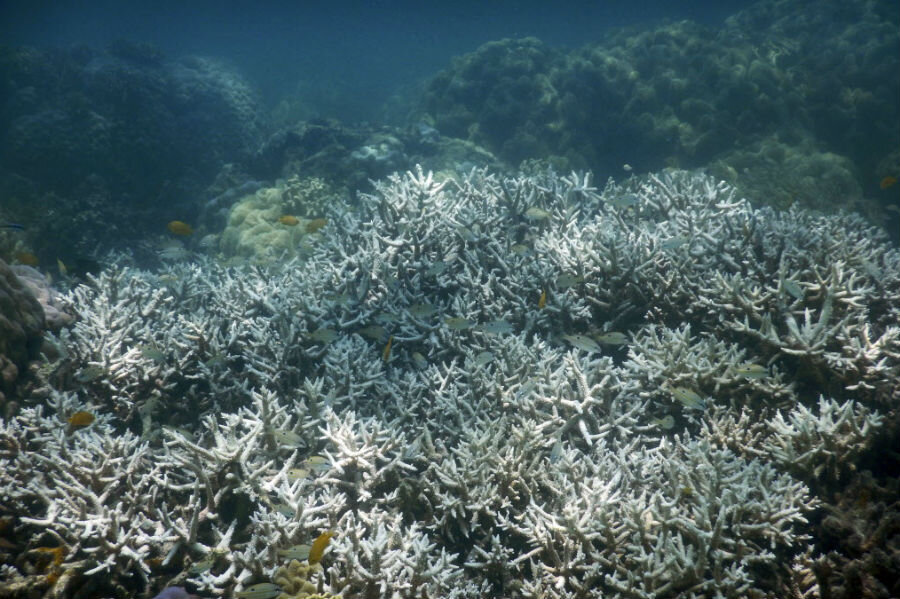Second mass bleaching event strikes Great Barrier Reef
Loading...
The famed Great Barrier Reef has been hit by a mass bleaching for the second year in a row, according to Australian authorities.
In 2016, the coral in the reef saw the worst bleaching in recorded history due to warm ocean temperatures, made even warmer by the El Niño weather pattern. Researchers had hoped that the reef might get a break during 2017 with the end of El Niño, but instead, the reef is suffering an unprecedented second mass bleaching in as many years.
Warming oceans, which have been largely linked by most scientists to human-caused climate change, have raised worries that this kind of frequent bleaching could become the new normal If it does, the entire ecosystem sustained by Great Barrier Reef could be at risk.
"We are seeing a decrease in the stress tolerance of these corals," Neal Cantin, from the Australian Institute of Marine Science (AIMS), said in a statement. "This is the first time the Great Barrier Reef has not had a few years between bleaching events to recover. Many coral species appear to be more susceptible to bleaching after more than 12 months of sustained above-average ocean temperatures."
Authorities at Australia's Great Barrier Reef Marine Park Agency (GBRMPA) began to notice that something was wrong in January, when reports of bleached coral from marine park rangers and other observers began to increase. In February, spot checks revealed moderate to severe bleaching in a number of locations. And then, on Thursday, workers for the Marine Park Authority took to the sky and discovered a major bleaching underway, particularly in the central part of the reef, which had largely escaped bleaching in 2016.
The full extent of the damage has not yet been assessed, as weather fluctuations over the next few weeks will continue to affect bleaching in the reef. But even if it is less extensive than last year's, the pattern that is unfolding doesn't look good, says GBRMPA's David Wachenfeld.
"To some extent it's not as important whether this event is not quite as bad or worse than last year's," Dr. Wachenfeld told the Australian Broadcasting Corporation. "I think what's important is that the climate is changing and that is bringing a much greater frequency of extreme weather events to the Great Barrier Reef. In total, those extreme weather events and the overall impact of climate change is a major threat to the future of the reef."
In 2016, mass bleaching led to a mass die-off of 67 percent of corals in the Great Barrier Reef's northern section. Six percent or less met the same fate in the central and southern sections, but further bleaching could become a threat to the entire reef over time. As Ben Thompson reported for The Christian Science Monitor last year:
Coral bleaching, the loss of endosymbiotic organisms that live within coral tissue, was not observed until late in the 20th century, leading many to infer that the process results from human causes. An Australian Institute of Marine Science researcher told Australia’s ABC News that signatures of bleaching were not observed until after severe events in the late 1990s and early 2000s. And the effect of rising temperatures on oceans related to human activity impacts the coral as well.
....
Coral bleaching is a phenomenon that causes coral to lose essential protozoan zooxanthellae that inhabit the reefs. The photosynthetic zooxanthellae, similar to algae, live within the tissues of coral and give the reefs their vibrant coloring.
Zooxanthellae are expelled through the bleaching process, which can result from environmental stresses such as rising temperatures and the introduction of sediments or chemicals, according to CSIRO. With the loss of zooxanthellae, coral quickly loses its color and appears bleach-white, stops growing, and may potentially die.
So what can be done to save the Great Barrier Reef?
"It's vital the world acts to implement the Paris Agreement to reduce greenhouse gas emissions," said Wachenfeld in a statement.
But the Paris Agreement, an international accord designed to limit greenhouse gas emissions and keep the average global temperature from climbing more than 2 degrees above preindustrial levels, may not be enough. On the campaign trail, Donald Trump promised to pull the United States out of the agreement, but even if the accords manage to stay on target with the United States fully on board, it still might not be enough to save the reef.
"The problem for coral is that 1.5 degrees [above preindustrial levels] is all the they can handle," Mark Eakin, Coordinator of NOAA’s Coral Reef Watch program told Gizmodo. "We're already up one degree and look what's already happening."
Scientists had suspected annual coral bleaching at the Great Barrier Reef could begin around 2050 without significant reductions in greenhouse gas emissions. But now, after consecutive two years of mass bleachings, it looks like that annual events of this type could come sooner than previously thought if no decisive action is taken to stop them.
"Just a few months ago, these corals were full of color and life," marine biologist Brett Monroe Garner, who has been documenting the bleaching event with Greenpeace, told The Guardian. "Now, everywhere you look is white.... If this is the new normal, we're in trouble."








